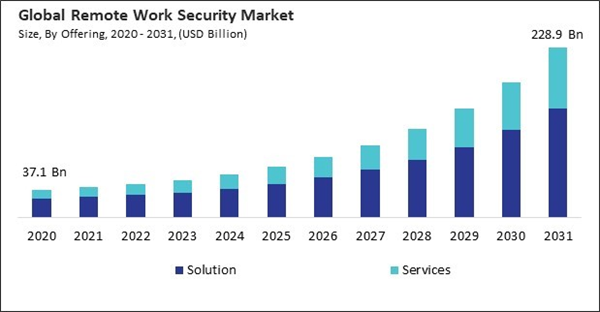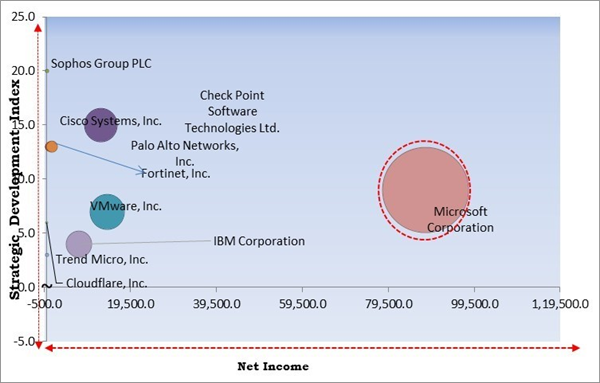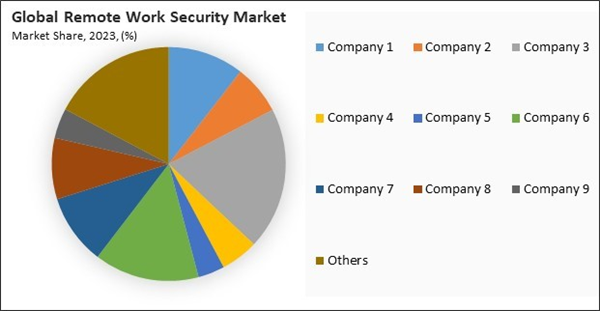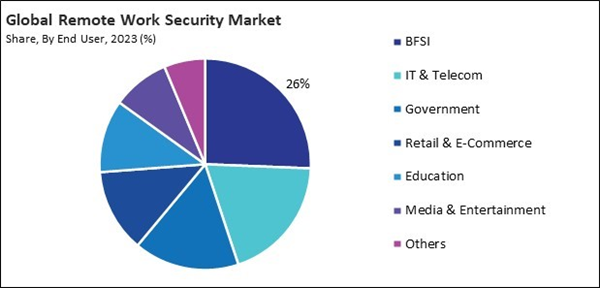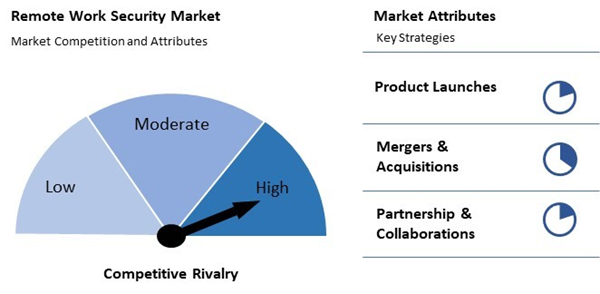The Global Remote Work Security Market size is expected to reach $228.9 billion by 2031, rising at a market growth of 21.7% CAGR during the forecast period.
Asia Pacific region has seen a significant increase in remote work arrangements due to factors such as the COVID-19 pandemic and shifting work preferences. Ensuring secure remote access to corporate networks and data is crucial as more employees work from home or other remote locations. Consequently, the Asia Pacific region would acquire nearly 30% of the total market share by 2031.
The major strategies followed by the market participants are Acquisitions as the key developmental strategy to keep pace with the changing demands of end users. For instance, in August, 2024, Fortinet has acquired Next DLP, a leader in insider risk and data protection. This acquisition enhances Fortinet’s position in the standalone enterprise data loss prevention (DLP) market and strengthens its integrated DLP solutions for endpoint and SASE, aligning with its strategic goals. Moreover, in May, 2024, Cloudflare has acquired BastionZero, a Zero Trust infrastructure access platform, to enhance remote access for Cloudflare One, its secure access service edge (SASE) solution. This integration provides secure access to critical IT systems, bolstering protection for organizations worldwide.
Based on the Analysis presented in the KBV Cardinal matrix; Microsoft Corporation is the forerunners in the Market. In August, 2021, Microsoft is acquiring San Francisco-based RiskIQ, a cybersecurity company specializing in threat intelligence and cloud-based software. This acquisition will further Microsoft’s mission to support customers and partners in defending their expanding digital environments against rising cyber threats. Companies such as Sophos Group PLC., Palo Alto Networks, Inc., and Cisco Systems, Inc. are some of the key innovators in Market.
As organizations adopt cloud computing for storage, applications, and collaboration tools, remote workers increasingly access these cloud-based resources. In addition, cloud computing enables remote workers to access corporate resources from anywhere. To ensure that only authorized users can access sensitive data and applications, it is essential to implement strong access management and authentication solutions. Thus, cloud computing growth is driving the growth of the market.
The leading players in the market are competing with diverse innovative offerings to remain competitive in the market. The above illustration shows the percentage of revenue shared by some of the leading companies in the market. The leading players of the market are adopting various strategies in order to cater demand coming from the different industries. The key developmental strategies in the market are Acquisitions.
The Market is fiercely competitive, fueled by the rising need for secure remote access solutions. Companies are innovating rapidly, offering advanced cybersecurity tools and cloud-based services. Established firms face stiff competition from startups, driving continuous improvements in threat detection, user authentication, and data protection technologies.
Asia Pacific region has seen a significant increase in remote work arrangements due to factors such as the COVID-19 pandemic and shifting work preferences. Ensuring secure remote access to corporate networks and data is crucial as more employees work from home or other remote locations. Consequently, the Asia Pacific region would acquire nearly 30% of the total market share by 2031.
The major strategies followed by the market participants are Acquisitions as the key developmental strategy to keep pace with the changing demands of end users. For instance, in August, 2024, Fortinet has acquired Next DLP, a leader in insider risk and data protection. This acquisition enhances Fortinet’s position in the standalone enterprise data loss prevention (DLP) market and strengthens its integrated DLP solutions for endpoint and SASE, aligning with its strategic goals. Moreover, in May, 2024, Cloudflare has acquired BastionZero, a Zero Trust infrastructure access platform, to enhance remote access for Cloudflare One, its secure access service edge (SASE) solution. This integration provides secure access to critical IT systems, bolstering protection for organizations worldwide.
KBV Cardinal Matrix - Market Competition Analysis
Based on the Analysis presented in the KBV Cardinal matrix; Microsoft Corporation is the forerunners in the Market. In August, 2021, Microsoft is acquiring San Francisco-based RiskIQ, a cybersecurity company specializing in threat intelligence and cloud-based software. This acquisition will further Microsoft’s mission to support customers and partners in defending their expanding digital environments against rising cyber threats. Companies such as Sophos Group PLC., Palo Alto Networks, Inc., and Cisco Systems, Inc. are some of the key innovators in Market.
Market Growth Factors
As more employees work remotely, the number of devices, networks, and endpoints accessing corporate systems increases. In addition, every remote device (laptop, smartphone, tablet) becomes an endpoint that needs to be secured. In addition, every remote device (laptop, smartphone, tablet) becomes an endpoint that needs to be secured.As organizations adopt cloud computing for storage, applications, and collaboration tools, remote workers increasingly access these cloud-based resources. In addition, cloud computing enables remote workers to access corporate resources from anywhere. To ensure that only authorized users can access sensitive data and applications, it is essential to implement strong access management and authentication solutions. Thus, cloud computing growth is driving the growth of the market.
Market Restraining Factors
Implementing comprehensive these security solutions often requires a substantial upfront investment. Alsos, advanced security solutions can be complex and require specialized skills for implementation and management. Thus, high implementation and maintenance costs are hampering the market’s growth.The leading players in the market are competing with diverse innovative offerings to remain competitive in the market. The above illustration shows the percentage of revenue shared by some of the leading companies in the market. The leading players of the market are adopting various strategies in order to cater demand coming from the different industries. The key developmental strategies in the market are Acquisitions.
Driving and Restraining Factors
Drivers
- Increased adoption of remote work
- Growth of cloud computing
- Escalation of cybersecurity threats worldwide
Restraints
- High implementation and maintenance costs
- Limited visibility into remote work environments
Opportunities
- Integration with the internet of things (IoT)
- Customized security for industry-specific needs
Challenges
- Lack of skilled cybersecurity professionals
- Latency and performance issues
Security Type Outlook
On the basis of security type, the market is segmented into endpoint & IoT security, network security, cloud security, and application security. The network security segment recorded 27% revenue share in the market in 2023. Remote work expands the attack surface as employees connect to corporate networks from various locations, including home networks and public Wi-Fi.End User Outlook
Based on end user, the market is divided into BFSI, IT and telecom, education, retail and e-commerce, government, media and entertainment, and others. The IT and telecom segment attained 19% revenue share in the market in 2023. The IT and telecom sectors provide essential services, including data processing, communication, and internet connectivity, which are vital for businesses and individuals.Offering Outlook
Work Model Outlook
By work model, the market is divided into full remote, hybrid, and temporary remote. The hybrid segment registered 33% revenue share in the market In 2023. Hybrid work environments typically combine on-premises infrastructure with cloud-based resources. Securing these integrated and often complex network architectures requires specialized network security solutions to manage and protect both environments.By Regional Analysis
Region-wise, the market is analyzed across North America, Europe, Asia Pacific, and LAMEA. The North America region witnessed 36% revenue share in the market in 2023. North America is a prime target for cybercriminals due to its many high-value targets, including major corporations and financial institutions.Market Competition and Attributes
The Market is fiercely competitive, fueled by the rising need for secure remote access solutions. Companies are innovating rapidly, offering advanced cybersecurity tools and cloud-based services. Established firms face stiff competition from startups, driving continuous improvements in threat detection, user authentication, and data protection technologies.
List of Key Companies Profiled
- Cisco Systems, Inc.
- VMware, Inc. (Broadcom Inc.)
- Palo Alto Networks, Inc.
- Check Point Software Technologies Ltd.
- Trend Micro, Inc.
- Fortinet, Inc.
- IBM Corporation
- Microsoft Corporation
- Sophos Group PLC (Thoma Bravo)
- Cloudflare, Inc.
Market Report Segmentation
By Offering
- Solution
- Services
By Work Model
- Full Remote
- Hybrid
- Temporary Remote
Security Type
- Endpoint & IoT Security
- Network Security
- Cloud Security
- Application Security
By End User
- BFSI
- IT & Telecom
- Government
- Retail & E-Commerce
- Education
- Media & Entertainment
- Others
By Geography
- North America
- US
- Canada
- Mexico
- Rest of North America
- Europe
- Germany
- UK
- France
- Russia
- Spain
- Italy
- Rest of Europe
- Asia Pacific
- China
- Japan
- India
- South Korea
- Singapore
- Malaysia
- Rest of Asia Pacific
- LAMEA
- Brazil
- Argentina
- UAE
- Saudi Arabia
- South Africa
- Nigeria
- Rest of LAMEA
Table of Contents
Chapter 1. Market Scope & Methodology
Chapter 2. Market at a Glance
Chapter 3. Market Overview
Chapter 4. Competition Analysis - Global
Chapter 5. Global Remote Work Security Market by Offering
Chapter 6. Global Remote Work Security Market by Work Model
Chapter 7. Global Remote Work Security Market by Security Type
Chapter 8. Global Remote Work Security Market by End User
Chapter 9. Global Remote Work Security Market by Region
Chapter 10. Company Profiles
Companies Mentioned
- Cisco Systems, Inc.
- VMware, Inc. (Broadcom Inc.)
- Palo Alto Networks, Inc.
- Check Point Software Technologies Ltd.
- Trend Micro, Inc.
- Fortinet, Inc.
- IBM Corporation
- Microsoft Corporation
- Sophos Group PLC (Thoma Bravo)
- Cloudflare, Inc.
Methodology

LOADING...



